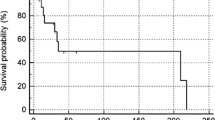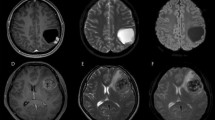Abstract
Introduction
Pleomorphic xanthoastrocytomas (PXAs) are classified as a grade II neoplasm, typically occur in children, and have favorable prognoses. However, their anaplastic counterparts remain poorly understood and vaguely characterized. In the present study, a large cohort of grade II PXA patients were compared with primary anaplastic PXA (APXA) patients to characterize patterns in treatment and survival.
Methods
Data were collected from the National Cancer Institute’s SEER database. Univariate and multivariate Cox regressions were used to evaluate the prognostic impact of demographic, tumor, and treatment-related covariates. Propensity score matching was used to balance baseline characteristics. Kaplan–Meier curves were used to estimate survival.
Results
A total of 346 grade II PXA and 62 APXA patients were identified in the SEER database between 2000 and 2016. Kaplan–Meier analysis revealed substantially inferior survival for APXA patients compared to grade II PXA patients (median survival: 51 months vs. not reached) (p < 0.0001). After controlling across available covariates, increased age at diagnosis was identified as a negative predictor of survival for both grade II and APXA patients. In multivariate and propensity-matched analyses, extent of resection was not associated with improved outcomes in either cohort.
Conclusions
Using a large national database, we identified the largest published cohort of APXA patients to date and compared them with their grade II counterparts to identify patterns in treatment and survival. Upon multivariate analysis, we found increased age at diagnosis was inversely associated with survival in both grade II and APXA patients. Receipt of chemoradiotherapy or complete surgical resection was not associated with improved outcomes in the APXA cohort.




Similar content being viewed by others
References
Kepes JJRL, Eng LF (1979) Pleomorphic xanthoastrocytoma: a distinctive meningocerebral glioma of young subjects with relatively favorable prognosis A study of 12 cases. Cancer 44(5):1839–1852
Ida CM, Rodriguez FJ, Burger PC et al (2015) Pleomorphic xanthoastrocytoma: natural history and long-term follow-up. Brain Pathol 25(5):575–586
Giannini CSB, Burger PC, Brat DJ, Wollan PC, Lach B et al (2000) Pleomorphic xanthoastrocytoma: what do we really know about it? Cancer 85(9):2033–2045
Rao AA, Laack NN, Giannini C, Wetmore C (2010) Pleomorphic xanthoastrocytoma in children and adolescents. Pediatr Blood Cancer 55(2):290–294
Gallo P, Cecchi PC, Locatelli F et al (2013) Pleomorphic xanthoastrocytoma: long-term results of surgical treatment and analysis of prognostic factors. Br J Neurosurg 27(6):759–764
Louis DN, Perry A, Reifenberger G et al (2016) The 2016 World Health Organization classification of tumors of the central nervous system: a summary. Acta Neuropathol 131(6):803–820
Kahramancetin N, Tihan T (2013) Aggressive behavior and anaplasia in pleomorphic xanthoastrocytoma: a plea for a revision of the current WHO classification. CNS Oncol 2(6):523–530
Tonse R, Gupta T, Epari S et al (2018) Impact of WHO 2016 update of brain tumor classification, molecular markers and clinical outcomes in pleomorphic xanthoastrocytoma. J Neurooncol 136(2):343–350
Giannini C, Louis D, Liberski P (2007) Pleomorphic xanthoastrocytoma. WHO classification of tumours of the central nervous system. IARC Press, Lyon, pp 22–24
Gelpi EPM, Preusser M, Budka H, Hainfellner J (2005) Pleomorphic xanthoastrocytoma with anaplastic features presenting without GFAP immunoreactivity: implications for differential diagnosis. Neuropathology 25(3):241–246
She D, Liu J, Xing Z, Zhang Y, Cao D, Zhang Z (2018) MR imaging features of anaplastic pleomorphic xanthoastrocytoma mimicking high-grade astrocytoma. AJNR Am J Neuroradiol 39(8):1446–1452
Hirose T, Ishizawa K, Sugiyama K, Kageji T, Ueki K, Kannuki S (2008) Pleomorphic xanthoastrocytoma: a comparative pathological study between conventional and anaplastic types. Histopathology 52(2):183–193
Phillips JJ, Gong H, Chen K et al (2019) The genetic landscape of anaplastic pleomorphic xanthoastrocytoma. Brain Pathol 29(1):85–96
Schindler G, Capper D, Meyer J et al (2011) Analysis of BRAF V600E mutation in 1,320 nervous system tumors reveals high mutation frequencies in pleomorphic xanthoastrocytoma, ganglioglioma and extra-cerebellar pilocytic astrocytoma. Acta Neuropathol 121(3):397–405
Wang J, Liu Z, Cui Y et al (2019) Evaluation of EZH2 expression, BRAF V600E mutation, and CDKN2A/B deletions in epithelioid glioblastoma and anaplastic pleomorphic xanthoastrocytoma. J Neurooncol 144(1):137–146
Vaubel RA, Caron AA, Yamada S et al (2018) Recurrent copy number alterations in low-grade and anaplastic pleomorphic xanthoastrocytoma with and without BRAF V600E mutation. Brain Pathol 28(2):172–182
Ma C, Feng R, Chen H et al (2018) BRAF V600E, TERT, and IDH2 mutations in pleomorphic xanthoastrocytoma: observations from a large case-series study. World Neurosurg 120:e1225–e1233
Tabouret E, Bequet C, Denicolai E et al (2015) BRAF mutation and anaplasia may be predictive factors of progression-free survival in adult pleomorphic xanthoastrocytoma. Eur J Surg Oncol 41(12):1685–1690
Patibandla MR, Nayak M, Purohit AK, Thotakura AK, Uppin M, Challa S (2016) Pleomorphic xanthoastrocytoma with anaplastic features: a rare case report and review of literature with reference to current management. Asian J Neurosurg 11(3):319
Ono T, Sasajima T, Shimizu H et al (2020) Molecular features and prognostic factors of pleomorphic xanthoastrocytoma: a collaborative investigation of the Tohoku Brain Tumor Study Group. Neurol Med Chir (Tokyo) 60(11):543–552
Liu J, Sun Y, Liu X (2020) Anaplastic pleomorphic xanthoastrocytoma: a case report and literature review. Int J Gen Med 13:1581–1587
Choudry UK, Khan SA, Qureshi A, Bari E (2016) Primary anaplastic pleomorphic xanthoastrocytoma in adults. Case report and review of literature. Int J Surg Case Rep 27:183–188
Watanabe N, Ishikawa E, Kohzuki H et al (2020) Malignant transformation of pleomorphic xanthoastrocytoma and differential diagnosis: case report. BMC Neurol 20(1):21
Rossello A, Plans G, Vidal-Sarro N, Fernandez-Coello A, Gabarros A (2017) Ganglioglioma progression to combined anaplastic ganglioglioma and anaplastic pleomorphic xanthoastrocytoma. Case report and literature review. World Neurosurg 108:996917–996925
Fukushima H, Nakano Y, Ishii N et al (2019) Histological and genetic analysis of anaplastic pleomorphic xanthoastrocytoma suspected of malignant progression over a 12-year clinical course. Pathol Int 69(10):608–613
Rutkowski MJ, Oh T, Niflioglu GG, Safaee M, Tihan T, Parsa AT (2016) Pleomorphic xanthoastrocytoma with anaplastic features: retrospective case series. World Neurosurg 95:368–374
Shaikh N, Brahmbhatt N, Kruser TJ et al (2019) Pleomorphic xanthoastrocytoma: a brief review. CNS Oncol 8(3):Cns39
Lim S, Kim JH, Kim SA, Park ES, Ra YS, Kim CJ (2013) Prognostic factors and therapeutic outcomes in 22 patients with pleomorphic xanthoastrocytoma. J Korean Neurosurg Soc 53(5):281–287
Yan J, Cheng J, Liu F, Liu X (2018) Pleomorphic xanthoastrocytomas of adults: MRI features, molecular markers, and clinical outcomes. Sci Rep 8(1):14275
Schmidt Y, Kleinschmidt-DeMasters BK, Aisner DL, Lillehei KO, Damek D (2013) Anaplastic PXA in adults: case series with clinicopathologic and molecular features. J Neurooncol 111(1):59–69
Ng WH, Lim T, Yeo TT (2008) Pleomorphic xanthoastrocytoma in elderly patients may portend a poor prognosis. J Clin Neurosci 15(4):476–478
Marton E, Feletti A, Orvieto E, Longatti P (2007) Malignant progression in pleomorphic xanthoastrocytoma: personal experience and review of the literature. J Neurol Sci 252(2):144–153
Fouladi M, Jenkins J, Burger P et al (2001) Pleomorphic xanthoastrocytoma: Favorable outcome after complete surgical resection. Neuro Oncol 3(3):184–192
Vu TM, Liubinas SV, Gonzales M, Drummond KJ (2012) Malignant potential of pleomorphic xanthoastrocytoma. J Clin Neurosci 19(1):12–20
Brown NF, Carter T, Mulholland P (2017) Dabrafenib in BRAFV600-mutated anaplastic pleomorphic xanthoastrocytoma. CNS Oncol 6(1):5–9
Lee EQ, Ruland S, LeBoeuf NR, Wen PY, Santagata S (2016) Successful treatment of a progressive BRAF V600E-mutated anaplastic pleomorphic xanthoastrocytoma with vemurafenib monotherapy. J Clin Oncol 34(10):e87-89
Migliorini D, Aguiar D, Vargas MI, Lobrinus A, Dietrich PY (2017) BRAF/MEK double blockade in refractory anaplastic pleomorphic xanthoastrocytoma. Neurology 88(13):1291–1293
Hussain F, Horbinski CM, Chmura SJ, Yamini B, Lukas RV (2018) Response to BRAF/MEK inhibition after progression with BRAF inhibition in a patient with anaplastic pleomorphic xanthoastrocytoma. Neurologist 23(5):163–166
Thomas AA, Tucker SM, Nelson CJ, Nickerson JP, Durham SR, Homans AC (2019) Anaplastic pleomorphic xanthoastrocytoma with leptomeningeal dissemination responsive to BRAF inhibition and bevacizumab. Pediatr Blood Cancer. 66(1):e27465
Lubansu A, Rorive S, David P et al (2004) Cerebral anaplastic pleomorphic xanthoastrocytoma with meningeal dissemination at first presentation. Childs Nerv Syst 20(2):119–122
Okazaki T, Kageji T, Matsuzaki K et al (2009) Primary anaplastic pleomorphic xanthoastrocytoma with widespread neuroaxis dissemination at diagnosis—a pediatric case report and review of the literature. J Neurooncol 94(3):431–437
Koga T, Morita A, Maruyama K et al (2009) Long-term control of disseminated pleomorphic xanthoastrocytoma with anaplastic features by means of stereotactic irradiation. Neuro Oncol 11(4):446–451
Perkins SM, Mitra N, Fei W, Shinohara ET (2012) Patterns of care and outcomes of patients with pleomorphic xanthoastrocytoma: a SEER analysis. J Neurooncol 110(1):99–104
Funding
None.
Author information
Authors and Affiliations
Corresponding author
Ethics declarations
Conflict of interest
The authors declare that they have no conflict of interest to disclose.
Additional information
Publisher's Note
Springer Nature remains neutral with regard to jurisdictional claims in published maps and institutional affiliations.
Supplementary Information
Below is the link to the electronic supplementary material.
Rights and permissions
About this article
Cite this article
Rodrigues, A., Bhambhvani, H., Medress, Z.A. et al. Differences in treatment patterns and overall survival between grade II and anaplastic pleomorphic xanthoastrocytomas. J Neurooncol 153, 321–330 (2021). https://doi.org/10.1007/s11060-021-03772-0
Received:
Accepted:
Published:
Issue Date:
DOI: https://doi.org/10.1007/s11060-021-03772-0




